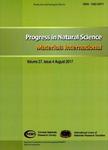Molecular architecture and engineering of spider dragline silk protein
Molecular architecture and engineering of spider dragline silk protein作者机构:Department of Biological Sciences and Biotechnology Tsinghua University Beijing 100084 China
出 版 物:《Progress in Natural Science:Materials International》 (自然科学进展·国际材料(英文))
年 卷 期:2005年第15卷第9期
页 面:769-776页
核心收录:
学科分类:0710[理学-生物学] 071010[理学-生物化学与分子生物学] 081704[工学-应用化学] 07[理学] 08[工学] 0817[工学-化学工程与技术] 0805[工学-材料科学与工程(可授工学、理学学位)] 0702[理学-物理学]
基 金:SupportedbytheNationalHighTechnologyResearchandDevelopmentProgramofChina(GrantNos.2002AA212051 2002AA206007and2004AA222100)andtheNationalBasicResearchandDevelopmentProgram(GrantNo.2004CB117300)
主 题:spider dragline silk protein modular structure molecular engineering.
摘 要:Spider dragline silk, which is produced in spider major ampullate gland, is a composite proteinacious fiber with highly repetitive Ala-Gly-rich domain. The unique combination of both high tensile strength and high elasticity makes spider dragline silk superior to almost any other natural or synthetic fibers. Cloning of the genes reveals that the silk is composed of at least two major proteins. Each protein component contains multiple repeats of modular structures that alternate between Ala-rich domains and Gly-rich domains. Molecular engineering not only opens a door to the production of spidroins but also provides a valuable experimental system to test and further establish the relationship between modular structures and mechanical properties. Here, based on our own studies, we review the latest progress of the modular structure and genetic engineering and outline the future prospects.



